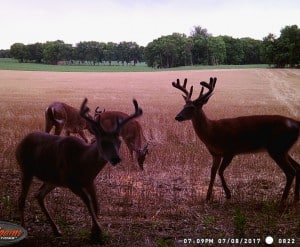If you’re out scouting and looking for deer in fields right now, you’re likely to spot at least one bachelor group of bucks. A gang of 2 to 3 to 8 bucks hanging out together in mid-summer is the norm, but I have seen as many as 12 boys in a group. Blog readers have emailed me over the years with reports of 15 to 19 bucks feeding and posturing together in a bean field in August! I suspect those mega-groups are actually 2 or 3 different bachelor groups that happened to come together.
Bachelor groups are interesting. Some of the best information I have read on the topic comes from an article posted on the QDMA website by Matt Ross. Here are 5 highlights from that post:
Bachelor groups may contain bucks of many different ages, including yearlings. Bucks in an individual bachelor group are usually not related to each other
Forming groups may aid in predator avoidance at a time when bucks are relatively defenseless…when antlers are growing and vulnerable to damage. Also, bachelor groups may allow local bucks to establish a basic dominance hierarchy through mild forms of aggression, which may reduce the amount of serious fighting necessary later
Bucks in bachelor groups get along well and even groom each other, but they still establish a basic “pecking order” within the group using aggressive physical displays, vocalizations, or sometimes hoof-flailing.
As day length begins to shorten (mid-August and September) testosterone levels (in the bucks) begin to rise, triggering the hardening of antlers and shedding of velvet. At this point, aggression within the group rises, and bucks begin to spar using their new antlers. Sparring is usually not serious and often involves bucks of widely differing age.
As the rut approaches and testosterone continues to rise, bucks gradually become less tolerant of each other, and the bachelor groups break apart… movement patterns and locations of each buck in a bachelor group may change radically after the group disbands.
So, those ganged-up bucks you see in fields over the next weeks may or may stay on your land come hunting season, but for now they sure are fun to watch.





